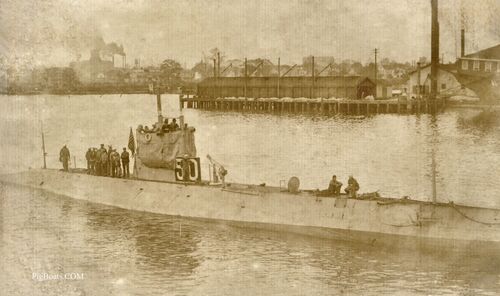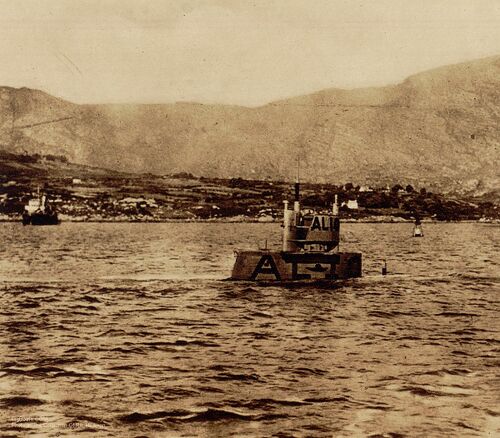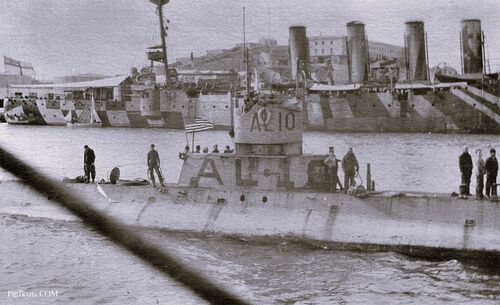L-10

This photo was originally a postcard, and when acquired by webmaster Ric Hedman it was heavily marked up with black postal cancelation stamping. PigBoats associate Matthew Tripp spent many hours in a painstaking effort to digitally restore the photo. Those restoration efforts resulted in this excellent result, but also account for some of the distortion in the upper left and lower right of the photo.
Photo in the private collection of Ric Hedman.

L-10 seen here making a dive in Bantry Bay, Ireland, summer 1918. This is a test dive to check systems and get a good fore and aft trim before heading out on patrol. The object seen just in front of the conning tower fairwater is the barrel of the 3"/23 caliber deck gun. It retracted into a vertical position when not in use, with the breech end enclosed in a watertight tub that penetrated into the pressure hull in the forward battery compartment. Bantry Bay was used by American and English submarines during WW I. American submarines would make 10 day patrols looking for German submarines and shipping to attack that were trying to sink Allied merchant and naval shipping.
Compared to today’s submarines that have a almost unlimited patrol time, these vessels were only capable of an average patrol of about 10 days. These boats had little food and freshwater storage and no refrigeration or air conditioning. Bathing and toilet facilities consisted of an open bucket. They were constantly damp inside making it nearly impossible to dry clothing. All of this severely affected the living conditions and limited the crew's endurance.
On one patrol the L-10 was heavily depth charged by the American destroyer USS Sterett (DD-27) in the Irish Sea after the submarine had developed an oil leak. The Sterett thought she had found a German U-boat. L-10 managed to surface and identify herself before the destroyer was able to use her guns to try and sink her.
Photo in the private collection of Ric Hedman.

L-10 with signal flags flying sailing past an American battleship, probably the USS Nevada (BB-36) in Bantry Bay, Ireland, summer of 1918.
Photo in the private collection of Ric Hedman.

L-10 loading a Bliss-Leavitt Mk 7 Mod 0 torpedo at her berth in Bantry Bay, Ireland, 1918. A rope and pulley system was attached to the periscope shears behind them, and the weapon was slowly winched down into the torpedo room and onto an inclined skid. Once fully inside the room the aft end of the skid was lowered to horizontal and the weapon/skid was pushed into position in the room.
Seen just forward and on either side of the open hatch are the three white painted heads of the K-tube passive sonar.
Photo in the private collection of Ric Hedman.

L-10 is shown here in Bantry Bay, Ireland passing a Royal Navy cruiser. This photo was taken from another ship, and the bar-like object in the foreground was part of the lifelines on that ship. The letter "A" added to the side of the fairwater was a simple expedient to avoid confusion with the RN L-class submarines that were operating in the same area. The "A" was removed once the boat returned to the states.
Photo in the private collection of Ric Hedman.

American sailors and soldiers manning the rail to watch as the L-10 passes them. The exact date is unknown, but could possibly be after the armistice as U.S. forces were gathering in UK waters to sail home, circa January 1919. L-10 is running on her port engine only, indicated by the exhaust from the port side. As is naval custom, the L-10 is rendering honors to the larger and more senior ship. A portion of the L-10's crew are lined up at attention topside, and one of her officers on the bridge is saluting.
Photo in the private collection of Ric Hedman.
Page created by:
Ric Hedman & David Johnston
1999 - 2023 - PigBoats.COM©
Mountlake Terrace, WA, Norfolk, VA
webmaster at pigboats dot com
